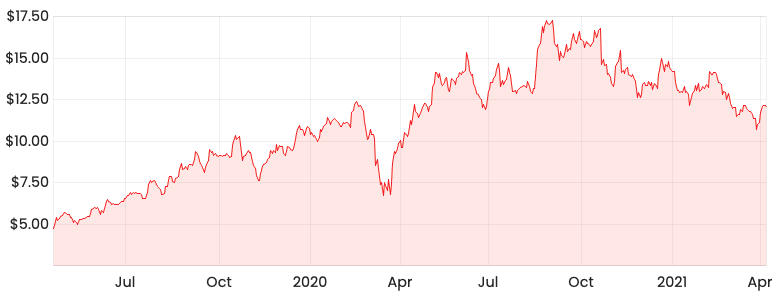Has the Megaport Ltd (ASX: MP1) share price gone from mega growth to mega value?
The Megaport share price has nearly dropped by 30% from its peak in September 2020. Is it a good time to go against the crowd?
Megaport share price

How did Megaport reach its share price peak?
Let’s go back in time and find out what was happening between July to September 2020.
It appears a lot of investors got excited about Megaport on the back of the federal government’s cyber security strategy. The government unveiled a $1.67 billion war chest to secure critical infrastructure and protect Australians from cyber attacks.
Why was this important for Megaport?
Megaport is a global provider of elastic interconnection services, enabling over 2,000 customers to connect to 700 data centres around the world.
Given the government’s investment in infrastructure such as data centres, it highlighted the importance of Megaport’s business.
As covered by my colleague Lachlan Buur-Jensen in his report on the half-year, HY21 results, Megaport operates in a market with structural growth. I believe this was the key driver of Megaport’s share price growth between July and September 2020.
The structural growth is due to more and more organisations adopting cloud-based services.
Why is the MP1 share price falling?
Whilst revenue is still growing at a high rate, it has been increasing at a slower rate year on year. I think this slowdown has played a part in not meeting investor’s initial growth expectations.
In addition, Megaport’s total net loss continues to worsen as it ramped up by 103% to -$38.4 million in HY21 compared to HY20.
The widening net loss is mainly due to the capital-intensive nature of Megaport’s business. The company needs to install network equipment to connect over 700 data centres globally.
Is Megaport still a sound investment?
It’s reasonable for investors to have reacted so negatively towards Megaport’s growing net loss. However, investors should be mindful that Megaport is building the rails for future growth.
These rails will be very difficult to remove once installed. So, even though Megaport is spending heavily on expanding its network of data centres, it’s being executed to achieve long-term growth.
As more businesses move to cloud services, more rails will need to be built to connect more data centres.
Over time, I would like to see payment for property, plant and equipment (PPE) as a percentage of cash receipts in the statement of cash flows trend downwards. This is a strong indicator that Megaport is scaling as it generates more cash from its PPE or rails.
Given Megaport is well-funded with $144.8 million in cash and low levels of debt, it is in a sound position to capitalise on the growing structural tailwind of cloud service adoption.
At Rask, we prefer businesses that can build a strong competitive advantage, and I think this business is displaying strong signals of this trait.









